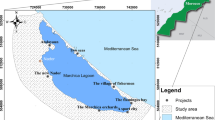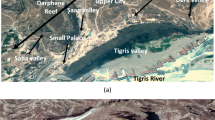Abstract
In this research a broad assessment of the geological, sedimentological and geotechnical characteristics of the coastal Holocene sediments of the Anzali Area was made and three engineering geological units as Upper Sandy Zone (USZ), Middle Clayey Zone (MCZ) and Lower Sandy Zone (LSZ) were identified. These units are the consequences of rapid sea-level fluctuations of the Caspian Sea in the Holocene. The engineering geological characteristics of these units were analyzed and the main engineering geological problems associated with sediments of each unit were identified. The results show that USZ has high liquefaction potential, low bearing capacity, settlement susceptibility and excavation problem. MCZ has low bearing capacity, high settlement susceptibility and excavation problem. LSZ that has good geotechnical properties poses few problems.
Access provided by Autonomous University of Puebla. Download conference paper PDF
Similar content being viewed by others
Keywords
1 Introduction
Anzali port is one of the most important ports in north of Iran along Caspian Sea coast (Fig. 1). This area is subjected to rapid urbanization and development. More recently growing population in addition to increasing tourism has lead to major construction in the study area, including development of buildings, roads, railroads, sewer networks and related infrastructures. These civil engineering activities upon coastal sediments having unfavorable engineering geological conditions have lead to (or will lead to) rising some engineering geological problems.
In this research the geo-environmental problems of the study area were assessed via a broad engineering geological investigation to provide the prerequisites for urban planning and development of the Anzali Area.
2 Geology and Engineering Geology
The recent deposits of the Caspian coast include beach and dune sands and swamp sediments. In addition a number of deltaic fans extend across the coastal plain to the sea (Clark et al. 1975; Annells et al. 1975). Figure 2 presents the geological map of the study area. As can be seen, the study area mainly consists of Holocene marine deposits and organo-detritic deposits. These sediments are the consequence of rapid sea-level changes of the Caspian Sea in the Holocene (Kazanci et al. 2004; Lahijani et al. 2009).
By characterizing the sediments of the study area, land units with similar behavior were defined. The data used for characterization were obtained from various geotechnical reports from both private and public projects across the study area. Moreover, nine dynamic cone penetrometer (DCP) tests were conducted to determine geotechnical properties of sandy soils up to 10 m in depth below ground surface.
Based on geotechnical data and sedimentological studies, the sediments of the study area can be divided to three units including USZ, MCZ and LSZ as Fig. 3. The LSZ and USZ are consequences of highstands of the Caspian Sea in Early and Late Holocene respectively and the MCZ has been deposited during lowstans of Caspian Sea in Middle Holocene in a lagoon environment. Main geotechnical properties of soils of these three units are given in Table 1.
3 Problems Associated With the Sediments
Saturated Holocene sediments of the Anzali Area with generally poor geotechnical properties like low shear strength and low density are associated with some problems including excavation problems, low bearing capacity, high settlement susceptibility and liquefaction potential. These problems are mainly associated with USZ and MCZ.
3.1 Excavation Problems
Loose sandy soils and low strength clayey soils in addition to shallow water table cause rising problems during excavations in USZ and MCZ. The groundwater table in the city of Anzali lies between 1.0 and 2.0 m. During the rainy season, the water table is higher than 1.0 m. Construction activities, therefore, often involve excavations of considerable depth underwater. The development of underground civil constructions in USZ below the water table requires rigorous and careful planning. The unforeseen events during the excavation works in saturated loose sandy soils of USZ can lead to serious problems, posing at risk surrounding buildings. One example of soil-related failures of underground structures built below the water table in USZ includes the excavation failure during micro-tunneling in fine sands in a sewer line project in the city of Anzali (Jebelli et al. 2010). In this case micro-tunneling in saturated sandy soil has led to partial soil loss due to short stand-up time and high groundwater pressure. Because excavations lead to unstable situations, thus it is often imperative to adopt bracing systems and lower the groundwater table. Invasion of water from both Caspian Sea and Anzali Lagoon to the sandy soils of USZ, make dewatering difficult in this unit.
3.2 Low Bearing Capacity
Superficial (up to 5 m in depth) sandy soils of USZ are not competent and have weak nature and low bearing capacity. As shown in Table 1, low SPT “N” values indicate low shear strength and low density of these soils that this fact in return demonstrates low bearing capacity of soils. In the case of heavy loads and high rise buildings up on USZ, pile foundations supported principally by end bearing would be required. Based on the depth of LSZ, the length of piles varies between 20 and 35 m from east to west parts.
Since the MCZ soils are very soft and have low bearing capacity, any structures up on these soils (in south and southeast of the City of Anzali) should be founded on pile foundations. Depth of competent sand stratum is relatively shallower in this area so pile foundation with maximum 15 m in length would be required.
LSZ appears at the ground surface in small parts in south of Anzali Lagoon. Based on the better geotechnical properties of the LSZ soils like higher SPT values, greater unit weight, and larger angle of internal friction, it appears that shallow foundation of any types at depths of 1.0–2.0 m would be suitable for most applications.
3.3 Settlement Susceptibility
Settlement susceptibility is mainly related to compressible nature of the clayey soils of MCZ. Evaluation of compressibility of MCZ soils was made based on the results of oedometer tests. The e-log p relationship does not show any definite overconsolidation. Moreover high natural moisture contents in comparison with liquid limits of the clayey soils of MCZ indicate that these soils are normally consolidated. The coefficient of compressibility (Cc), extracted from the record, ranged between 0.14 and 1.1 (Table 1). The high Cc values (>0.25) are attributed to high in situ void ratios and moisture contents. These values are indicative of their vulnerability to excessive settlements under applied loads.
3.4 Liquefaction Potential
USZ soils are young and comprising sandy material with low relative density that occurring in saturated conditions. Moreover, the southern Caspian Sea region is seismically active based on many historical and instrumental records of earthquakes (Jackson et al. 2002). Considering abovementioned conditions, it can be deduced that the sandy soils of USZ have high liquefaction potential. In this regard, the factor of safety (FS) of USZ against liquefaction was determined based on the SPT data (Youd and Idriss 2001). For determination of FS, a peak horizontal acceleration (amax) of 0.35 g and an earthquake magnitude of M7.5 were considered for the area based on Nogol-e-Sadat (1991). Based on determined FS against liquefaction, in many cases the USZ soils have high liquefaction potential (the FS less than one).
Another evaluation of liquefaction potential was made based on DCP test results. In this case, Liquefaction Potential Index (LPI) of USZ was determined for each DCP test location (Fig. 4) based on Luna and Frost (1998) and Sonmez (2003). For determination of FS (needed for determination of LPI), a peak horizontal acceleration (amax) of 0.35 g, an earthquake magnitude of M7.5 and mean value of 15 % for fine contents of the USZ soils were considered. Table 2 shows the liquefaction potential index of USZ soils based on DCP test results and their liquefaction potential classification. As shown in Table 2, USZ soils have mainly high and very high liquefaction potential based on DCP test results.
4 Conclusions
In this research the engineering geological conditions of Holocene sediments of the Anazli area were investigated based on geological and sedimentological studies, DCP test results and geotechnical data collected over the study area. The results show that the sediments of the study area have high degree of engineering geological problems that should be taken into account during planning and construction of infrastructures in the Anzali area. The results of this study could be used for prediction of geological conditions in new foundation sites in the study area. With this information, the planners are able to coordinate urban development plans with unfavorable engineering geological conditions to achieve a sustainable development of the study area.
References
Annells, R., Arthurton, R., Bazley, R. et al. (1975) Explanatory text of the Qazvin and Rasht Quadrangles Map 1:250000. Geological survey of Iran.
Clark, G., Davies, R., Hamzepour, B., et al. (1975) Explanatory text of the Bandar-e-Anzali Quadrangle Map 1:250000. Geological survey of Iran.
Jackson, J., Priestley, K., Allen, M., et al. (2002). Active tectonic of the south Caspian basin. Geophysical Journal International, 148, 214–245.
Jebelli, J., Meguid, M., & Sedghinejad, M. (2010). Excavation failure during micro-tunneling in fine sands: A case study. Tunneling and Underground Space Technology, 25, 811–818.
Kazancı, N., Gulbabazadeh, T., Leroyd, S., et al. (2004). Sedimentary and environmental characteristics of the Gilan–Mazenderan plain, northern Iran: influence of long- and short-term Caspian water level fluctuations on geomorphology. Marine Systems, 46, 145–168.
Lahijani, H. A. K., Rahimpour-Bonab, H., Tavakoli, V., et al. (2009). Evidence for late Holocene highstands in Central Guilan–East Mazanderan, South Caspian coast. Iran. Quaternary International, 197, 55–71.
Luna, R., & Frost, J. (1998). Spatial liquefaction analysis system. Journal of Computing in Civil Engineering, 12(1), 48–56.
Sonmez, H. (2003). Modification of the liquefaction potential index and liquefaction susceptibility mapping for a liquefaction-prone area (Inegol, Turkey). Environmental Geology, 44(7), 862–871.
Nogol-e-Sadat, M. (1991). Comprehensive geological studies of Guilan Province. Guilan: Governmental office of Guilan Province.
Youd, T., & Idriss, I. (2001). Liquefaction resistance of soils: summary report from the 1996 NCEER and 1998 NCEER/NSF workshop on evaluation of Liquefaction resistance of soils. Journal of Geotechnical and Geo-environmental Engineering, 127(10), 817–833.
Author information
Authors and Affiliations
Corresponding author
Editor information
Editors and Affiliations
Rights and permissions
Copyright information
© 2013 Springer-Verlag Berlin Heidelberg
About this paper
Cite this paper
Hashemi, M., Nikoudel, M.R., Moghaddas, N.H., Khamehchiyan, M. (2013). Engineering Geological Assessment of the Anzali Coastal Region (North Iran, South Caspian Coast) to Sustain Urban Planning and Development. In: Huang, Y., Wu, F., Shi, Z., Ye, B. (eds) New Frontiers in Engineering Geology and the Environment. Springer Geology. Springer, Berlin, Heidelberg. https://doi.org/10.1007/978-3-642-31671-5_22
Download citation
DOI: https://doi.org/10.1007/978-3-642-31671-5_22
Publisher Name: Springer, Berlin, Heidelberg
Print ISBN: 978-3-642-31670-8
Online ISBN: 978-3-642-31671-5
eBook Packages: Earth and Environmental ScienceEarth and Environmental Science (R0)












